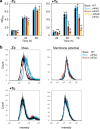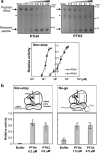A stalled-ribosome rescue factor Pth3 is required for mitochondrial translation against antibiotics in Saccharomyces cerevisiae
- PMID: 33686140
- PMCID: PMC7940416
- DOI: 10.1038/s42003-021-01835-6
A stalled-ribosome rescue factor Pth3 is required for mitochondrial translation against antibiotics in Saccharomyces cerevisiae
Abstract
Mitochondrial translation appears to involve two stalled-ribosome rescue factors (srRFs). One srRF is an ICT1 protein from humans that rescues a "non-stop" type of mitochondrial ribosomes (mitoribosomes) stalled on mRNA lacking a stop codon, while the other, C12orf65, reportedly has functions that overlap with those of ICT1; however, its primary role remains unclear. We herein demonstrated that the Saccharomyces cerevisiae homolog of C12orf65, Pth3 (Rso55), preferentially rescued antibiotic-dependent stalled mitoribosomes, which appear to represent a "no-go" type of ribosomes stalled on intact mRNA. On media containing a non-fermentable carbon source, which requires mitochondrial gene expression, respiratory growth was impaired significantly more by the deletion of PTH3 than that of the ICT1 homolog PTH4 in the presence of antibiotics that inhibit mitochondrial translation, such as tetracyclines and macrolides. Additionally, the in organello labeling of mitochondrial translation products and quantification of mRNA levels by quantitative RT-PCR suggested that in the presence of tetracycline, the deletion of PTH3, but not PTH4, reduced the protein expression of all eight mtDNA-encoded genes at the post-transcriptional or translational level. These results indicate that Pth3 can function as a mitochondrial srRF specific for ribosomes stalled by antibiotics and plays a role in antibiotic resistance in fungi.
Conflict of interest statement
The authors declare no competing interests.
Figures





Similar articles
-
Misdecoding of rare CGA codon by translation termination factors, eRF1/eRF3, suggests novel class of ribosome rescue pathway in S. cerevisiae.FEBS J. 2019 Feb;286(4):788-802. doi: 10.1111/febs.14709. Epub 2018 Dec 11. FEBS J. 2019. PMID: 30471181 Free PMC article.
-
Structural basis of translation termination, rescue, and recycling in mammalian mitochondria.Mol Cell. 2021 Jun 17;81(12):2566-2582.e6. doi: 10.1016/j.molcel.2021.03.042. Epub 2021 Apr 19. Mol Cell. 2021. PMID: 33878294
-
Ribosome rescue and translation termination at non-standard stop codons by ICT1 in mammalian mitochondria.PLoS Genet. 2014 Sep 18;10(9):e1004616. doi: 10.1371/journal.pgen.1004616. eCollection 2014 Sep. PLoS Genet. 2014. PMID: 25233460 Free PMC article.
-
Structure and Function of the Mitochondrial Ribosome.Annu Rev Biochem. 2016 Jun 2;85:103-32. doi: 10.1146/annurev-biochem-060815-014343. Epub 2016 Mar 24. Annu Rev Biochem. 2016. PMID: 27023846 Review.
-
Rescuing stalled mammalian mitoribosomes - what can we learn from bacteria?J Cell Sci. 2020 Jan 2;133(1):jcs231811. doi: 10.1242/jcs.231811. J Cell Sci. 2020. PMID: 31896602 Review.
Cited by
-
Mutation of the PEBP-like domain of the mitoribosomal MrpL35/mL38 protein results in production of nascent chains with impaired capacity to assemble into OXPHOS complexes.Mol Biol Cell. 2023 Dec 1;34(13):ar131. doi: 10.1091/mbc.E23-04-0132. Epub 2023 Oct 4. Mol Biol Cell. 2023. PMID: 37792492 Free PMC article.
-
Mammalian HEMK1 methylates glutamine residue of the GGQ motif of mitochondrial release factors.Sci Rep. 2022 Mar 8;12(1):4104. doi: 10.1038/s41598-022-08061-y. Sci Rep. 2022. PMID: 35260756 Free PMC article.
-
Knockout of the mitoribosome rescue factors Ict1 or Mtrfr is viable in zebrafish but not mice: compensatory mechanisms underlying each factor's loss.FEBS Open Bio. 2025 Aug;15(8):1303-1318. doi: 10.1002/2211-5463.70054. Epub 2025 May 16. FEBS Open Bio. 2025. PMID: 40376928 Free PMC article.
References
Publication types
MeSH terms
Substances
LinkOut - more resources
Full Text Sources
Other Literature Sources
Medical
Molecular Biology Databases

